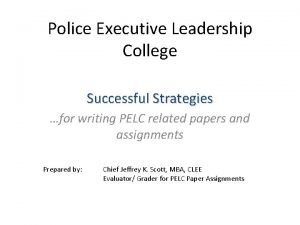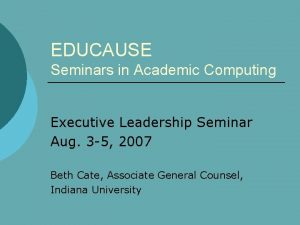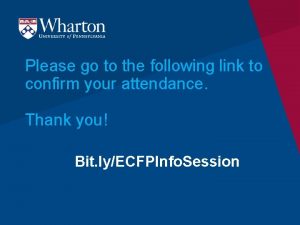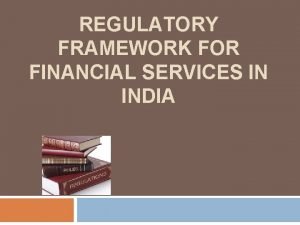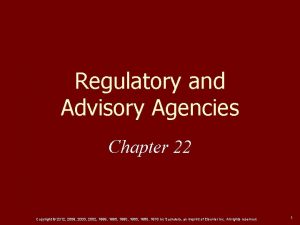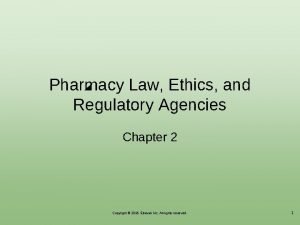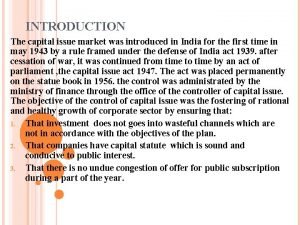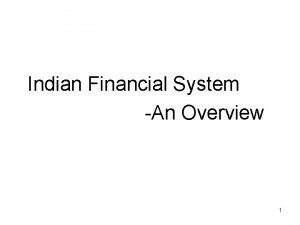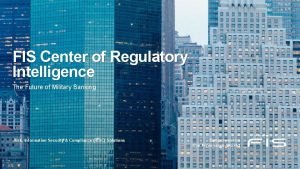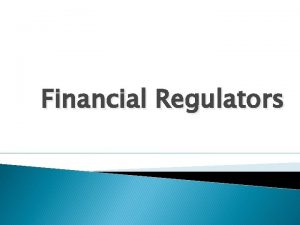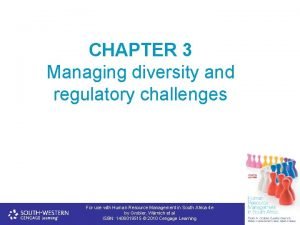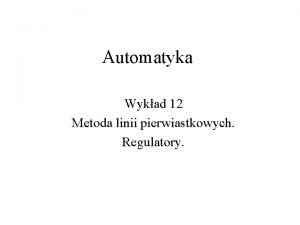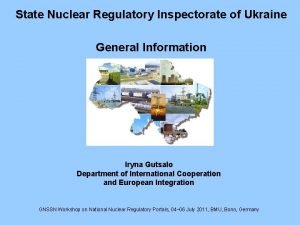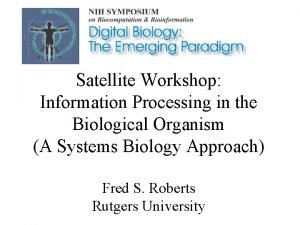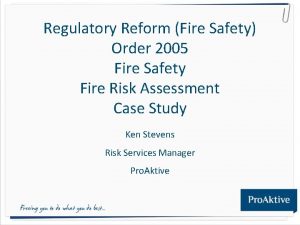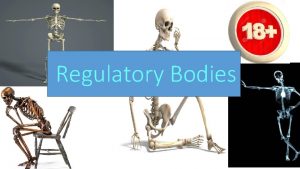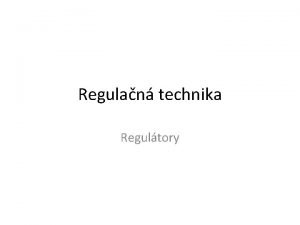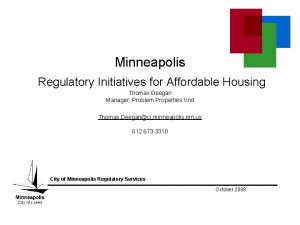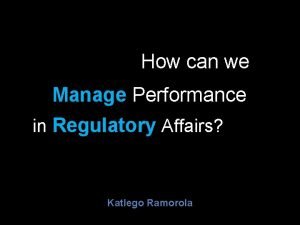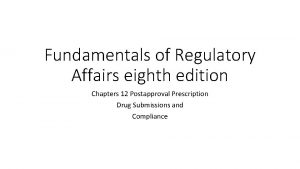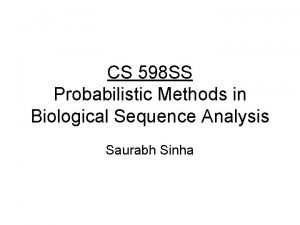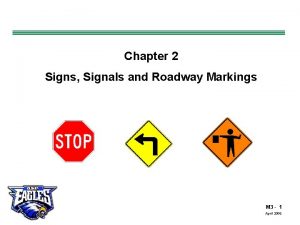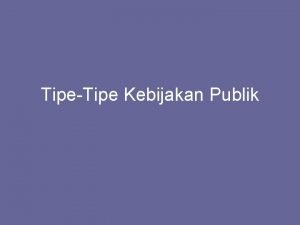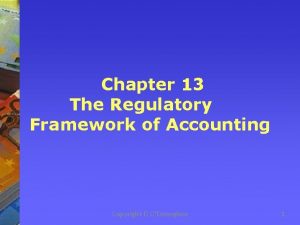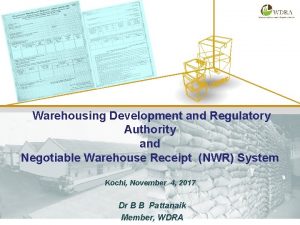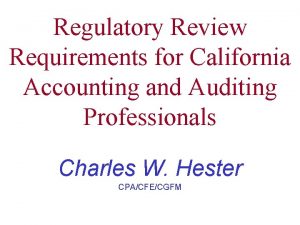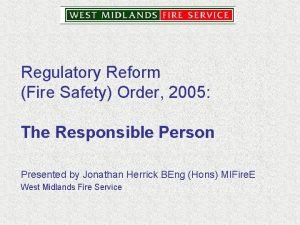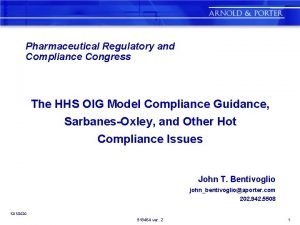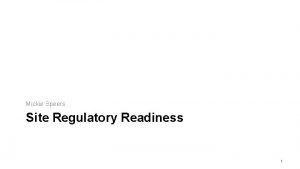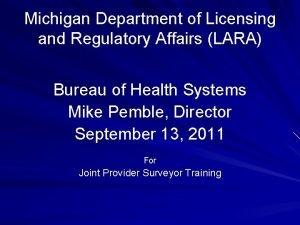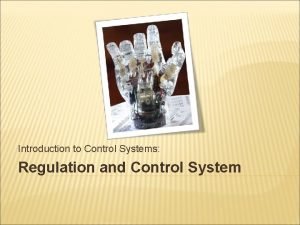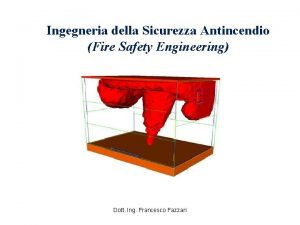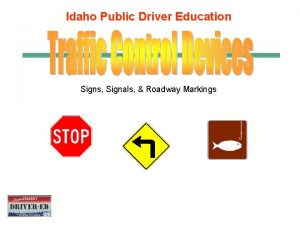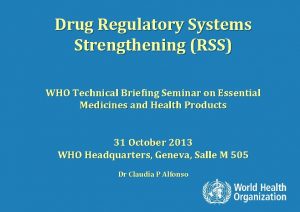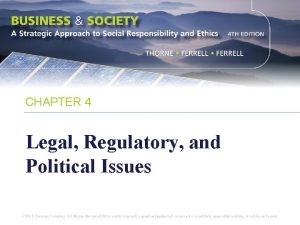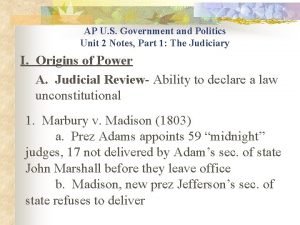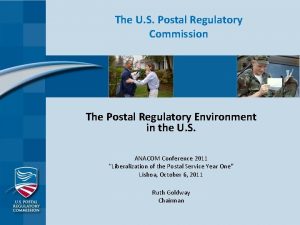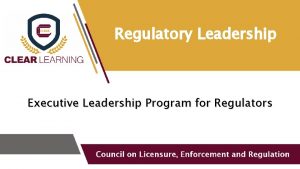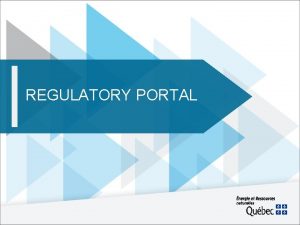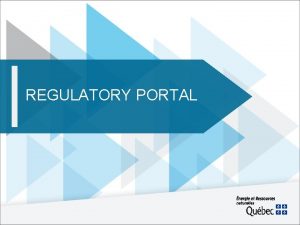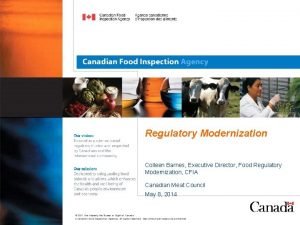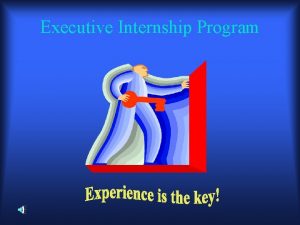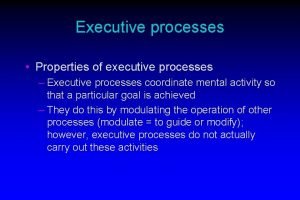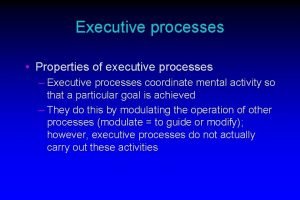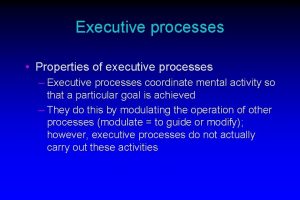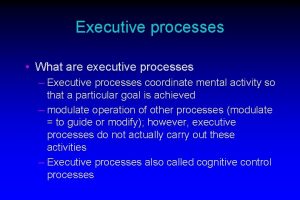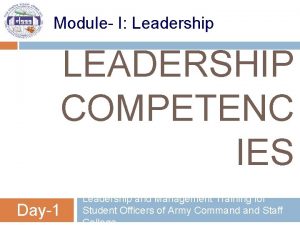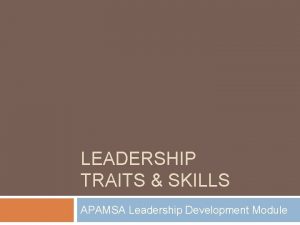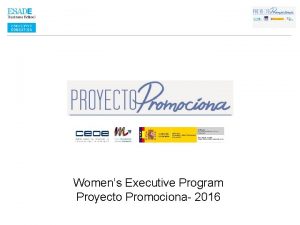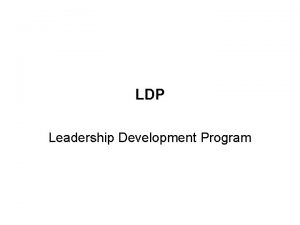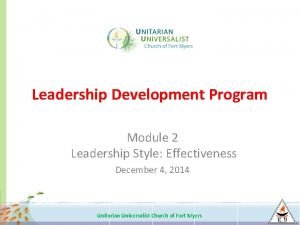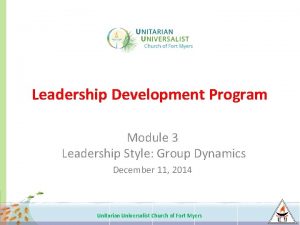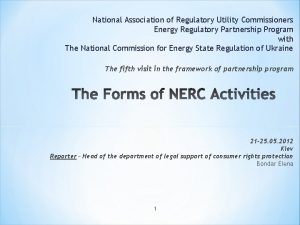Module I Regulatory Leadership Executive Leadership Program Module






















































- Slides: 54

Module I – Regulatory Leadership Executive Leadership Program

Module Introduction

Learning Objectives § Upon completion of the session, you will be able to: § Share two ‘situational leadership styles’ you have used § Define the leadership style appropriate for specified situations § Reflect on regulatory leadership in today’s world § Identify factors that challenge leadership generally

Learning Objectives § Upon completion of this session you will be able to: § Reflect on how types of intelligence impact your own performance and ability to lead § Consider the challenges to (good) regulatory leadership and how you deal with these § Identify skills for dealing with conflicts and sustaining good inter/personal relationships

Learning Objectives § Upon completion of the session, you will be able to: § Recognize the link between leadership and culture § List the top characteristics of regulatory leadership § Link “vision” to the possibilities of change § Explain the difference between leadership and regulatory leadership

Learning Objectives § Upon completion of the session, you will be able to: § Understand the difference between “power” and “authority” § Recognize what appropriate use of power +/or authority means for a regulatory leader § Identify the characteristics needed to be a ‘right touch regulatory leader’

Learning Objectives § Upon completion of the session, you will be able to: § Describe a personal experience when a problematic leadership practice by another influenced your ability to perform § Identify your own strengths, and areas needing development regarding leadership traits

Module Map Regulatory Leadership Defined The Leadership/Emotional Intelligence Connection Characteristics of Regulatory Leadership Styles and Types of Leadership Challenges to (Good)Regulatory Leadership Problematic Leadership Practices

Leadership Defined

Leadership Defined § Knowing where to go and what needs to happen to get there § Being able- to influence people or groups toward one or more goals § Marshaling necessary resources § Inspiring others § Demonstrating integrity

Leadership and Emotional Intelligence

Intelligence Defined § Wechsler § Formed basis of defining and measuring intelligence § Traditional IQ test was the Stanford Binet test § Other intelligence types

Types and Relationships of Intelligence § Intelligence Quotient (IQ) § Tacit Knowledge (TK) § Emotional Intelligence (EI)

Emotional Intelligence “… a type of social intelligence that involves the ability to monitor one’s own and others’ emotions, to discriminate among them, and to use the information to guide one’s thinking and actions" (Mayer & Salovey, 1980)

Emotional Intelligence Domains and Associated Competencies

Social Awareness and Relationships § How we manage relationships § Building and sustaining ‘necessary’ relationships § Dealing with conflicts § Resolving issues

Social Awareness § Empathy § Organizational and Environmental Awareness § Political Climate § Ability to Anticipate and to React

Relationship Management § Inspiration § Leveraging diversity § Political awareness § Influence § Conflict management* § Communication § Leadership § Change catalyst § Building bonds § Teamwork and collaboration

Self Management § Self-Control § Transparency § Adaptability § Innovation § Achievement Drive § Initiative § Optimism

Self Awareness § Emotional awareness (ongoing reflection) § Accurate self-assessment (honesty) § Self-confidence (not arrogance) § *Is what you think aligned with others’ thinking?

Discussion Topic § Why do intelligent people fail?

Impact on Performance § Evidence is that EI is key in creating a positive working environment and improving business performance. § Star Performers exhibit excellence in six or more competencies with at least one from each cluster. § Effective Leaders demonstrate EQ and IQ traits. § IQ is not in itself a reliable predictor of success.

Top Competencies § Achievement Orientation § Developing Others § Adaptability § Influence § Self Confidence § Inspirational Leadership § Good Communicator

Why Executive Leaders Derail § The Centre for Creative Leadership’s three primary causes of derailment: § Difficulty handling change § Not working well in a team § Poor interpersonal relationships.

Roadblocks to Emotional Intelligence § Fear and Worry § Avoidance (pain, conflict) § Low(er) Self- Esteem § Unrealistic Expectations § Tendency to Blame Others

Emotional Competencies § EI alone is not a strong predictor of job performance. § EI is the bedrock for these competencies which are directly linked to performance. § Emotional Competence refers to the personal and social skills that lead to superior performance.

Emotional Intelligence Self-Assessment § Materials needed: § Results from online self-scored emotional intelligence test completed prior to attending this course. § Discussion topics § Individual results § Questions regarding the assessment § Surprises you discovered about yourself? § Things you already knew?

Goleman’s Stages of Successful, Sustainable Change My Ideal Self Who I Am Now My Learning Agenda Experimentation Developing Relationships § My ideal self – Who do I want to be? § Who I am now § Who am I? § What are my strengths and areas for improvement? § My learning agenda § How can I build on my strengths while reducing my gaps?

Goleman’s Stages of Successful, Sustainable Change My Ideal Self Who I Am Now My Learning Agenda Experimentation Developing Relationships § Experimentation § Practicing new behaviors, thoughts, and feelings to the point of mastery § Developing supportive and trusting relationships § Act as mentors, trusted advisors to make change possible

Characteristics of Regulatory Leadership

Characteristics of Regulatory Leadership Is there a difference between a leader and a regulatory leader?

Discussion Topic § Think about a recent experience with someone you consider a leader § What did you admire most about this person? § How did they make you feel about yourself? § What techniques or actions did they use to get you to perform?

Discussion Topic § What are some characteristics of good regulatory leaders?

Characteristics of Regulatory Leadership Managers get things done right; leaders do the right thing! -Author Unknown

What Challenges Us as Regulatory Leaders? § Inter-generational Issues § Increased scrutiny § Public confidence and trust § Issues with other regulators § Technology § Cyber security § Changing roles – how is today’s regulator different?

Styles and Types of Leadership

Situational Leadership Styles § Directive § Coach § Supportive § Delegating § The ideal leader moves between these four styles depending on the situation

Leadership Styles and Traits § Autocratic § Laissez-faire § Democratic § Participative § Visionary § Diplomatic § Pacesetter § Commanding § Planner and thinker § Motivator § Communicator and teacher

Discussion Topic As a member of the senior leadership team in your regulatory organization, you attend a meeting with government officials, who want to propose new rules that will have significant impact on the work of your registrants/licensees. You believe the proposed rules will not be well received, and are not likely to be supported by, or get the approval of your Board/Council. How would you handle this request and what leadership traits would you call on?

Leading with Authority

The “Right-Touch” Regulatory Leader § Doing the right things § Doing them right § Focusing on optimal outcomes for consumer safety and protection* § Using the right amount of enforcement to achieve them

Leading to Influence § Regulatory leaders may have a role in influencing: § Policy § Legislation/regulations § Board or Council decisions/directions § Strategic planning § Individuals and teams within organization

Influencing Tactics § Rational persuasion § Inspirational appeal § Consultation § Ingratiation § Exchange/Barter § Personal appeal § Coalition/Compromise § Exerting Authority § Pressure

Problematic Leadership

Problematic Regulatory Leadership Practices § Overreaching § Being risk averse § Running roughshod over subordinates § Being cold and aloof § Need to be ‘the Star’ § Being inordinately concerned with getting ahead § Inability to set priorities

Problematic Regulatory Leadership Practices § Pushing too hard and burning out § Too rigid or difficult to influence § Too concerned with status symbols, and trappings of power § Not delegating

Problematic Regulatory Leadership Practices § An inflated sense of one’s own importance § Distorting reality to create a favorable impression § Lack of integrity

Just Plain Bad Leadership § 2 categories of bad leadership: § Ineffective § Unethical § 7 prevalent types: § Incompetent § Rigid § Intemperate § Callous § Corrupt § Insular § Evil

Discussion Question § Does the organization make the leader, or does the leader make the organization?

Module Review

Learning Objectives Review § You should now be able to: § Share two ‘situational leadership styles’ you have used § Define the leadership style appropriate for specified situations § Reflect on regulatory leadership in today’s world § Identify factors that challenge leadership generally

Learning Objectives Review § You should now be able to: § Reflect on how types of intelligence impact your own performance and ability to lead § Consider the challenges to (good) regulatory leadership and how you deal with these § Identify skills for dealing with conflicts and sustaining good inter/personal relationships

Learning Objectives Review § You should now be able to: § Recognize the link between leadership and culture § List the top characteristics of regulatory leadership § Link “vision” to the possibilities of change § Explain the difference between leadership and regulatory leadership

Questions
 Business ethics chapter 5
Business ethics chapter 5 Diversity
Diversity Police executive leadership college
Police executive leadership college Executive leadership seminars
Executive leadership seminars Secdef executive fellowship
Secdef executive fellowship Singularity university faculty
Singularity university faculty Wharton executive coaching and feedback program
Wharton executive coaching and feedback program C device module module 1
C device module module 1 Unit 3 assessing risk in sport
Unit 3 assessing risk in sport Dispositional framework vs regulatory framework
Dispositional framework vs regulatory framework Traffic signs purpose
Traffic signs purpose Regulatory framework for financial services in india
Regulatory framework for financial services in india Chapter 22 regulatory and advisory agencies
Chapter 22 regulatory and advisory agencies Chapter 2 pharmacy law ethics and regulatory agencies
Chapter 2 pharmacy law ethics and regulatory agencies Milady blood exposure procedure
Milady blood exposure procedure Regulatory functions of sebi
Regulatory functions of sebi Functions of financial system
Functions of financial system Regulatory change management process
Regulatory change management process Objective of irda
Objective of irda Managing diversity and regulatory challenges
Managing diversity and regulatory challenges Regulatory sign color
Regulatory sign color Basle ii
Basle ii Regulatory capital vs economic capital
Regulatory capital vs economic capital Regulatory w automatyce
Regulatory w automatyce Gene regulatory network
Gene regulatory network Infoatoms
Infoatoms Which is the shape of a no passing zone sign?
Which is the shape of a no passing zone sign? Gene regulatory network
Gene regulatory network Regulatory reform fire safety order 2005
Regulatory reform fire safety order 2005 Film regulatory bodies
Film regulatory bodies Nespojité regulátory
Nespojité regulátory Minneapolis regulatory services
Minneapolis regulatory services Kpi regulatory affairs
Kpi regulatory affairs Post approval regulatory affairs
Post approval regulatory affairs Gene regulatory network
Gene regulatory network Chapter 2 signs, signals, and roadway markings
Chapter 2 signs, signals, and roadway markings Pengertian kebijakan protektif adalah ..
Pengertian kebijakan protektif adalah .. Regulatory framework accounting
Regulatory framework accounting Warehouse regulatory and development authority
Warehouse regulatory and development authority Regulatory creep
Regulatory creep California cpa regulatory review
California cpa regulatory review The regulatory reform (fire safety) order 2005 summary
The regulatory reform (fire safety) order 2005 summary Oig pharma compliance guidance
Oig pharma compliance guidance Regulatory agencies
Regulatory agencies Regulatory readiness checklist
Regulatory readiness checklist Michigan licensing and regulatory affairs
Michigan licensing and regulatory affairs Missile launcher control system
Missile launcher control system Ingegneria sicurezza antincendio
Ingegneria sicurezza antincendio Driver education signs
Driver education signs Regulatory system strengthening
Regulatory system strengthening Legal regulatory and political issues
Legal regulatory and political issues Dispositional framework vs regulatory framework
Dispositional framework vs regulatory framework Regulatory system strengthening
Regulatory system strengthening Regulatory agencies
Regulatory agencies Usps regulatory commission
Usps regulatory commission


